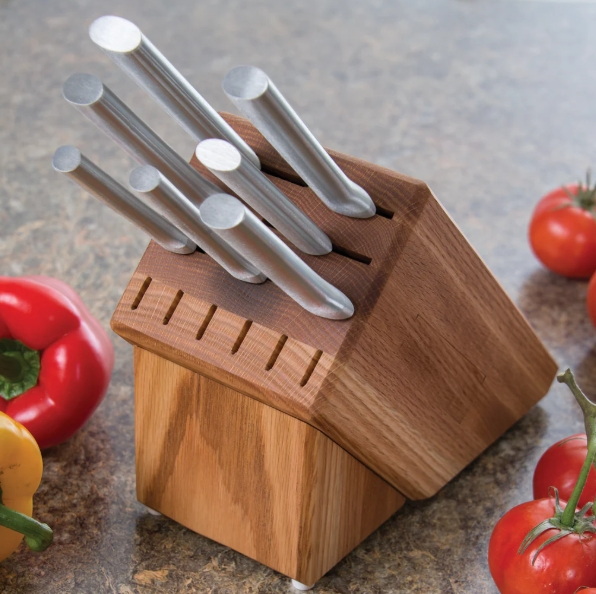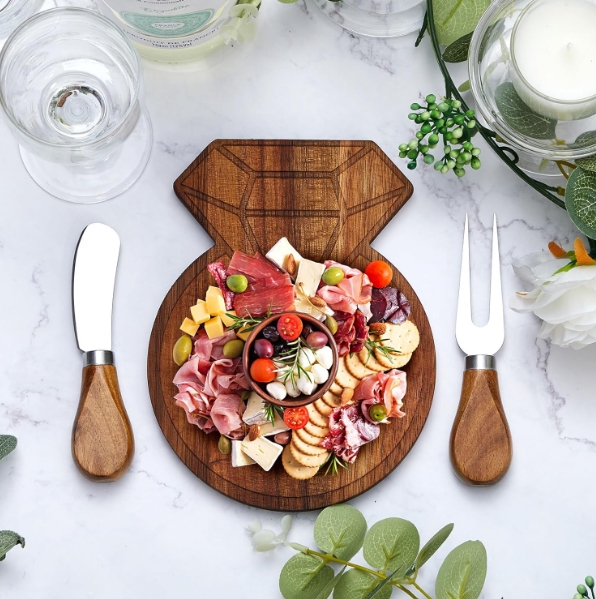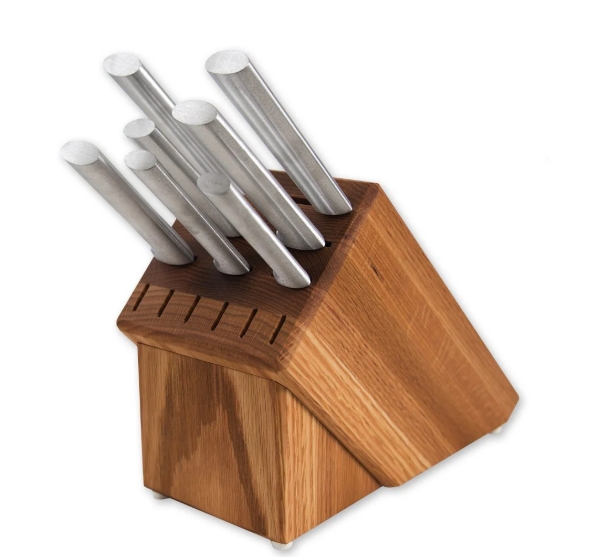

Views: 222 Author: Ella Publish Time: 2025-05-06 Origin: Site








Content Menu
● Why the Right Knife Set Matters
● Understanding Knife Types and Their Uses
>> Chef's Knife
>> Paring Knife
>> Boning Knife
>> Fillet Knife
>> Cleaver
● Key Features to Look for in a Knife Set
>> Construction
>> Maintenance
● Top Knife Sets for Meat, Fish, and Vegetables
>> Wüsthof Classic 10-Piece Knife Block Set
>> Chicago Cutlery Fusion Knife Set
>> Schmidt Brothers 6-Piece BBQ Knife Set
>> Farberware Edgekeeper Block Set
>> MDHAND 10-Piece Chef Knife Set
● How to Care for Your Knife Set
>> Cleaning
>> Sharpening
>> Storage
>> Oiling
● Knife Skills: Tips for Cutting Meat, Fish, and Vegetables
>> Meat
>> Fish
>> Vegetables
>> Rock Chop
● How to Choose the Best Knife Set for Your Needs
>> Set a Budget
>> Read Reviews
● Maintaining Your Knife Set Over Time
● Frequently Asked Questions (FAQ)
>> 1. What knives are essential in a set for meat, fish, and vegetables?
>> 2. How often should I sharpen my kitchen knives?
>> 3. Are Japanese or German knives better for home cooks?
>> 4. Can I put my knives in the dishwasher?
>> 5. What's the safest way to store kitchen knives?
Choosing the right knife set is one of the most important decisions you can make for your kitchen. Whether you're slicing through a thick roast, filleting a delicate fish, or dicing a medley of fresh vegetables, the right knives make every task easier, safer, and more enjoyable. In this comprehensive guide, we'll explore what makes a knife set truly great for a wide range of ingredients, review some of the top options on the market, and provide tips for care, maintenance, and skill development. By the end, you'll have all the knowledge you need to select the perfect knife set for your culinary adventures.

The kitchen knife is an extension of the chef's hand. Using the wrong knife can turn meal prep into a struggle, leading to uneven cuts, torn meat fibers, squashed vegetables, or even injuries. On the other hand, a well-chosen knife set allows you to work with confidence and precision, enhancing both the look and taste of your dishes.
A quality knife set is a long-term investment. With proper care, a good set can last decades, making your time in the kitchen more efficient and enjoyable. Whether you're a home cook or an aspiring chef, the right tools make all the difference.
The chef's knife is the workhorse of the kitchen. Its broad, sharp blade is ideal for chopping, slicing, and dicing everything from meat to vegetables. The curved edge allows for a rocking motion, making it easy to process large quantities of ingredients quickly.
Small and nimble, the paring knife is perfect for peeling, trimming, and detailed work. Use it for deveining shrimp, hulling strawberries, or segmenting citrus.
The serrated or bread knife is designed to cut through foods with tough exteriors and soft interiors. It's perfect for slicing bread, tomatoes, and citrus fruits without crushing them.
With its thin, flexible blade, the boning knife is engineered to remove bones from meat, poultry, and fish. Its sharp point and narrow profile allow for precise cuts close to the bone.
The fillet knife is similar to the boning knife but even more flexible, making it ideal for filleting fish. Its thin blade glides smoothly along the backbone and under the skin.
These Japanese-style knives excel at slicing, dicing, and mincing vegetables. The santoku's slightly curved blade is great for chopping, while the nakiri's straight edge is perfect for push-cutting vegetables.
A heavy-duty blade designed for breaking down large cuts of meat and chopping through bones or tough vegetables. It's also useful for crushing garlic or ginger.
Smaller than a chef's knife but larger than a paring knife, the utility knife is a versatile tool for slicing sandwiches, cutting cheese, or trimming fat.
Shears are invaluable for snipping herbs, trimming fat, or breaking down poultry. Some sets include heavy-duty shears that can cut through small bones.
- High-Carbon Stainless Steel: Offers an excellent balance of sharpness, durability, and resistance to rust and stains.
- Damascus Steel: Known for its beautiful layered appearance and exceptional sharpness.
- Ceramic: Extremely sharp and lightweight, but more brittle and prone to chipping.
- Full Tang: The blade extends through the handle, providing superior balance and strength.
- Forged vs. Stamped: Forged knives are made from a single piece of steel and tend to be stronger and more durable. Stamped knives are cut from a sheet and are usually lighter and less expensive.
- Ergonomics: Look for handles that fit comfortably in your hand and provide a secure grip, even when wet.
- Material: Handles can be made from wood, plastic, resin, or composite materials. Each has its own feel and maintenance requirements.
A well-balanced knife feels stable and comfortable, reducing fatigue during long prep sessions. Some cooks prefer heavier knives for chopping meat, while others like lighter blades for precision work.
Choose a set that covers all your basic needs without unnecessary extras. A good set typically includes a chef's knife, paring knife, serrated knife, boning or fillet knife, and a utility or santoku knife.
- Sharpening Tools: Some sets include a honing steel or built-in sharpener.
- Storage: Knife blocks, magnetic strips, or protective sheaths keep blades safe and sharp.

This premium set includes all the essentials: chef's, paring, serrated, bread, carving, and utility knives, plus kitchen shears and a honing steel. Wüsthof knives are known for their sharpness, balance, and durability. The full-tang, triple-riveted handles provide excellent control, and the high-carbon stainless steel blades retain their edge for a long time.
A stylish and affordable option, this set features high-carbon stainless steel blades and comfortable, soft-grip handles. It includes chef's, santoku, utility, paring, bread, and steak knives, making it versatile enough for most home cooks.
Perfect for meat lovers, this set focuses on BBQ and large cuts. It includes butcher, slicing, chef's, and boning knives, plus a carving fork and a portable knife roll. The knives are sharp, well-balanced, and beautifully designed.
This value-packed set includes a built-in sharpener, full-tang knives, and a wide range of blades, including chef's, santoku, bread, slicing, boning, cleaver, utility, paring, carving fork, steak knives, and shears. It's a great choice for budget-conscious cooks who want a comprehensive set.
A Japanese-style set featuring stainless steel knives designed for chopping, slicing, and cutting meat, fish, and vegetables. It's affordable, sharp, and versatile, making it a good option for beginners.
Always hand wash your knives with warm, soapy water immediately after use. Dry them thoroughly to prevent rust and corrosion. Avoid putting knives in the dishwasher, as the high heat and detergents can damage both the blade and the handle.
Use a honing steel regularly to maintain the edge. For sharpening, use a whetstone, manual or electric sharpener, or take your knives to a professional. Keeping your knives sharp not only makes cutting easier but also safer, as dull blades are more likely to slip.
Store your knives in a wooden block, on a magnetic strip, or in blade guards to protect the edges and prevent accidents. Never toss knives loose in a drawer.
If you have carbon steel knives, apply a thin layer of food-safe oil after cleaning to prevent rust.
- Use a sharp chef's or carving knife for slicing roasts and steaks.
- For deboning, use a boning knife to work close to the bone.
- Let cooked meat rest before slicing to retain juices.
- Use a flexible fillet knife to follow the contours of the fish.
- Remove pin bones with tweezers for a clean fillet.
- For sashimi or sushi, use a yanagiba or specialized sushi knife.
- Use a chef's knife or santoku for chopping, dicing, and mincing.
- For fine work like peeling or segmenting, use a paring knife.
- Keep your fingers tucked under (the “claw” grip) for safety.
- Paper Test: Hold a sheet of paper and try to slice through it with your knife. A sharp blade will cut cleanly without tearing.
- Tomato Test: Try slicing a ripe tomato. A sharp knife will glide through the skin without crushing the fruit.
- Onion Test: A sharp knife will let you dice an onion without slipping or squashing.
Use the curved edge of a chef's knife to rock back and forth, making quick work of herbs and vegetables.
Master fine cuts for vegetables to enhance presentation and even cooking.
Learn to butterfly chicken breasts or spatchcock a whole bird for even cooking and better flavor absorption.
- Always cut on a stable surface, using a cutting board.
- Keep your knives sharp to reduce the risk of slipping.
- Store knives properly to prevent accidents.
- Never try to catch a falling knife.
- Use the right knife for the job to maintain control and precision.
Think about the types of meals you prepare most often. Do you cook a lot of meat, or are you more of a vegetable enthusiast? Do you enjoy preparing fish or seafood? Choose a set that matches your culinary style.
Knife sets range from affordable to high-end. While you don't need to spend a fortune, investing in quality pays off in the long run.
If possible, visit a store and hold the knives in your hand. Check the balance, weight, and grip to ensure they feel comfortable.
Look for feedback from other cooks to learn about durability, sharpness, and ease of maintenance.
- Sharpen your knives regularly to keep them performing at their best.
- Replace or repair damaged knives to maintain a complete set.
- Clean and dry knives immediately after use to prevent rust and corrosion.
- Store knives safely to protect the blades and your hands.
Selecting the best knife set for cutting meat, fish, and vegetables is a personal journey that depends on your cooking style, preferences, and budget. By understanding the different types of knives, key features to look for, and proper care techniques, you can make an informed decision that will serve you well for years to come. Whether you're a beginner or a seasoned chef, the right knife set will elevate your kitchen skills, make meal prep safer, and bring more joy to your cooking.

A well-rounded set should include a chef's knife, paring knife, serrated/bread knife, boning or fillet knife, and a utility or santoku knife. These cover most cutting tasks for meat, fish, and vegetables.
Sharpen your knives when you notice a decline in performance-typically every few months for home use. Use a honing steel regularly to maintain the edge between sharpening sessions.
Both are excellent but have different strengths. Japanese knives are lighter and sharper, ideal for precision tasks like slicing vegetables and fish. German knives are heavier, more robust, and versatile for meat and general use.
It's best to hand wash all quality knives. Dishwashers can dull the blades and damage handles, especially with high heat and harsh detergents.
Store knives in a wooden block, on a magnetic strip, or in blade guards. Avoid tossing them in a drawer, which can dull the blades and increase the risk of injury.